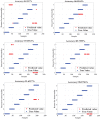Research on line loss analysis and intelligent diagnosis of abnormal causes in distribution networks: artificial intelligence based method
- PMID: 38192464
- PMCID: PMC10773768
- DOI: 10.7717/peerj-cs.1753
Research on line loss analysis and intelligent diagnosis of abnormal causes in distribution networks: artificial intelligence based method
Abstract
The primary source of energy losses in distribution networks (DNs) is rooted in line losses, which is crucial to conduct a thorough and reasonable examination of any unusual sources of line losses to guarantee the power supply in a timely and safe manner. In recent studies, identifying and analyzing abnormal line losses in DNs has been a widely and challenging research subject. This article investigates a key technology for the line loss analyses of DNs and intelligent diagnosis of abnormal causes by implementing artificial intelligence (AI), resulting in several prominent results. The proposed algorithm optimizes the parameters of the support vector machine (SVM) and suggests an intelligent diagnosis algorithm called the Improved Sparrow Search Algorithm and Support Vector Machine (ISSA-SVM). The ISSA-SVM algorithm is trained to calculate the data anomalies of line losses when changing loads and exhibiting exceptional performance to identify abnormal line losses. The accuracy of abnormality identification employing the ISSA-SVM algorithm reaches an impressive 98%, surpassing the performances of other available algorithms. Moreover, the practical performance of the proposed approach for analyzing large volumes of abnormal line loss data daily in DNs is also noteworthy. The ISSA-SVM accurately identifies the root causes of abnormal line losses and lowers the error in calculating abnormal line loss data. By combining different types of power operation data and creating a multidimensional feature traceability model, the study successfully determines the factors contributing to abnormal line losses. The relationship between transformers and voltage among various lines is determined by using the Pearson correlation, which provides valuable insights into the relationship between these variables and line losses. The algorithm's reliability and its potential to be applied to real-world scenarios bring an opportunity to improve the efficiency and safety of power supply systems. The ISSA that incorporates advanced techniques such as the Sobol sequence, golden sine algorithm, and Gaussian difference mutation appears to be a promising tool.
Keywords: Abnormal causes; Distribution network; Intelligent diagnosis; Line loss; Sparrow search algorithm; Support vector machine.
© 2023 Liao et al.
Conflict of interest statement
The authors declare that they have no competing interests. All the authors are employed by Electric Power Research Institute, Yunnan Power Grid Co., Ltd.
Figures
References
-
- Hosseini ZS, Mahoor M, Khodaei A. AMI-enabled distribution network line outage identification via multi-label SVM. IEEE Transactions on Smart Grid. 2018;9(5):5470–5472. doi: 10.1109/TSG.2018.2849845. - DOI
-
- Houran MA, Salman MA, Bukhari SM, Zafar MH, Mansoor M, Chen W. COA-CNN-LSTM: coati optimization algorithm-based hybrid deep learning model for PV/wind power forecasting in smart grid applications. Applied Energy. 2023;349(3):121638. doi: 10.1016/j.apenergy.2023.121638. - DOI
-
- Hu W, Guo Q, Liu Y, Wang W, Wang Y, Song S. Real-time line loss calculation method based on equivalent resistance of low voltage distribution network. 2021 China International Conference on Electricity Distribution (CICED); Shanghai, China: 2021. pp. 1045–1049.
-
- Huang S, Wu Q, Cheng L, Liu Z. Optimal reconfiguration-based dynamic tariff for congestion management and line loss reduction in distribution networks. IEEE Transactions on Smart Grid. 2016;7(3):1295–1303. doi: 10.1109/TSG.2015.2419080. - DOI
-
- Li C, Cai Q, Lou Y. Optimal data placement strategy considering capacity limitation and load balancing in geographically distributed cloud. Future Generation Computer Systems. 2022;127:142–159. doi: 10.1016/j.future.2021.08.014. - DOI
LinkOut - more resources
Full Text Sources




